Last updated on March 6th, 2024 at 02:19 am
Aloe vera plants stand out among succulents, valued not just for their visual appeal but also for their impressive healing properties and minimal maintenance requirements. Known for its robust, fleshy leaves containing a renowned soothing gel, the unique feature of these leaves lies in their ability to eliminate allergens, toxins, and pollutants from the air. Indeed, the aloe vera plant falls into the category of air-purifying plants, although caution should be exercised as its leaves possess toxicity for people, cats, and dogs if consumed.
This tropical gem, often referred to as Aloe barbadensis miller within a group boasting over 300 different species, showcases elongated leaves with serrated edges. Under optimal conditions, this resilient plant displays vibrant, spiky flowers in red, orange, or yellow hues. However, flowering requires patience, especially for younger plants, which may take years to bloom.
Contents
- 1 Maturity and Reproduction
- 2 Basic Care For Aloe Vera Plant
- 3 FAQS
- 3.1 What kind of potting soil should I select for my aloe vera plant?
- 3.2 Are aloe vera plants safe for pets?
- 3.3 How do I trim or prune my aloe vera plant?
- 3.4 What mistakes should I avoid when caring for Aloe vera plants?
- 3.5 Can I use any pot for planting my Aloe Vera?
- 3.6 How do I deal with pests on my aloe vera plant?
- 3.7 How long until an aloe vera plant blooms?
- 4 Author
Maturity and Reproduction
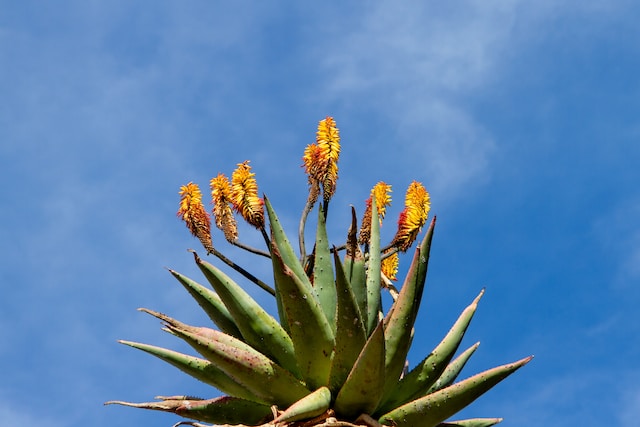
Within three to four years, the aloe vera plants mature, unveiling an intriguing trait—its ability to reproduce through new shoots, a delightful opportunity for gardening enthusiasts eager to share this abundant succulent. Stemless or with a short stem, the aloe vera plants efficiently retain moisture within their leaves, thriving in well-lit environments with adequate moisture and favorable temperatures.
Occasionally, indoor cultivators may take pleasure in witnessing their aloe vera plant adorned with tubular blossoms in vivid shades, enhancing the beauty of their nurturing efforts. Whether you’re an experienced gardener or starting your botanical journey, tending to an aloe vera promises a fulfilling experience where beauty, health benefits, and the wonders of nature harmoniously converge.”
Basic Care For Aloe Vera Plant
Because it loves plenty of light, needs little water, and doesn’t require much fertilizer, aloe vera is perfect for beginners. The aloe plant you keep indoors has the potential to survive for as long as 12 years with appropriate care.
Let’s explore how to care aloe vera plant. Understanding its light requirements, proper watering techniques, minimal fertilizer needs, and how to choose the best pot will keep the indoor aloe vera plant healthy. We’ll guide you through each step to ensure the well-being of this robust succulent.
Fertilizing
Aloes don’t need a lot of fertilizer. It’s best to fertilize them lightly in spring before they start growing again. You can use a regular houseplant fertilizer or one made for succulents and cacti. Just follow the instructions on the package and use only half the recommended amount. Feed them once a month in spring and summer with a diluted balanced houseplant formula. While feeding can make them grow a bit faster, remember, aloe vera plants are tough and can do well even without regular fertilizing.
Light
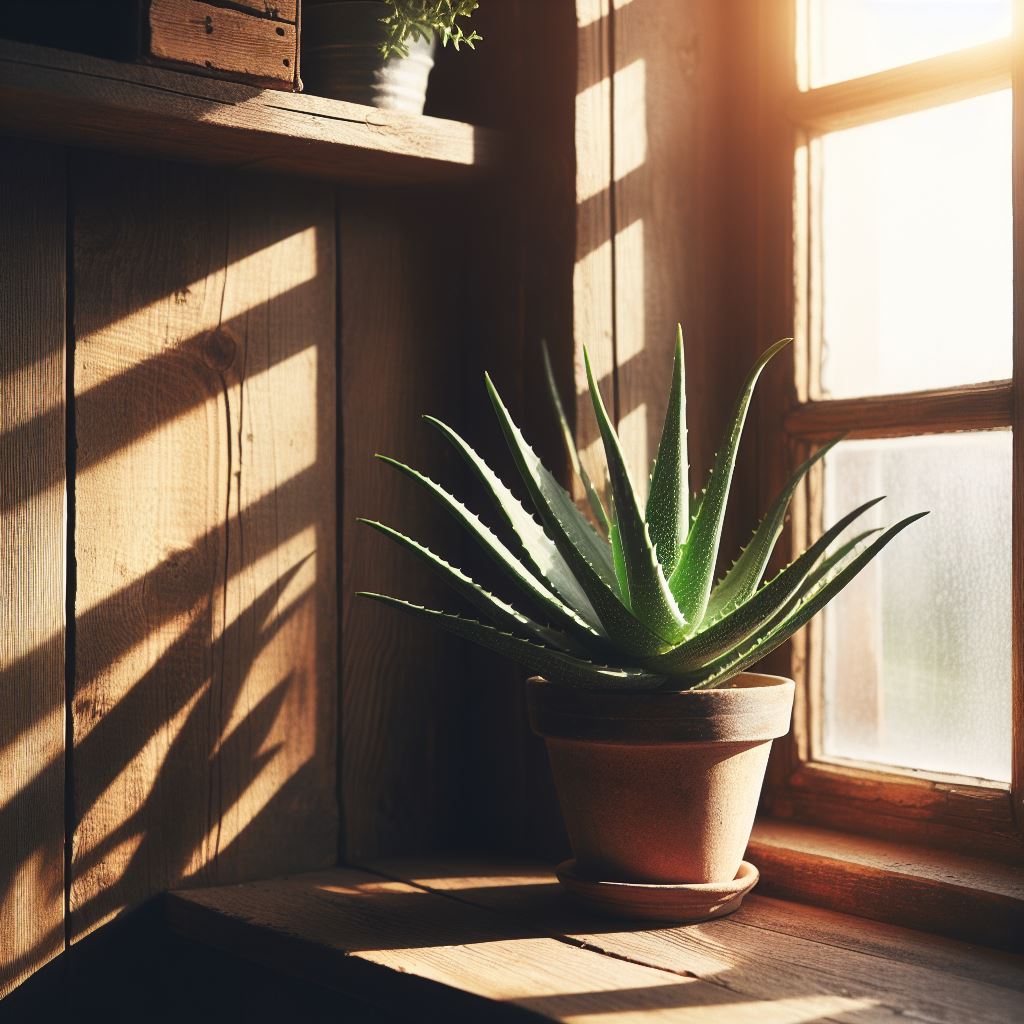
For healthy aloe vera plants ensure they receive indirect yet bright sunlight. Placing the aloe vera near a window that receives ample sunshine, especially in southern or western-facing windows, is ideal. If you intend to grow aloe vera outdoors, choose a sunny location but avoid sudden exposure of an indoor plant to direct sunlight, which could lead to sunburn. In areas lacking sufficient natural light, consider using grow lights to supplement.
However, if relying on artificial lighting, remember to allow your plants breaks by placing them in a dark room or closet periodically. Aloe vera kept in consistently low light conditions tends to grow slowly.
Watering
Aloe vera plants, such as succulents, don’t need frequent watering to thrive and may suffer from issues like mold or root rot if overwatered. Typically, watering once a week is sufficient, but during hot, dry spells, consider watering twice a week. During fall and winter, reduce watering frequency compared to the summer months. Always ensure the soil is entirely dry before you water the aloe vera plant. This plant prefers occasional but thorough watering for optimal growth.
4-Soil
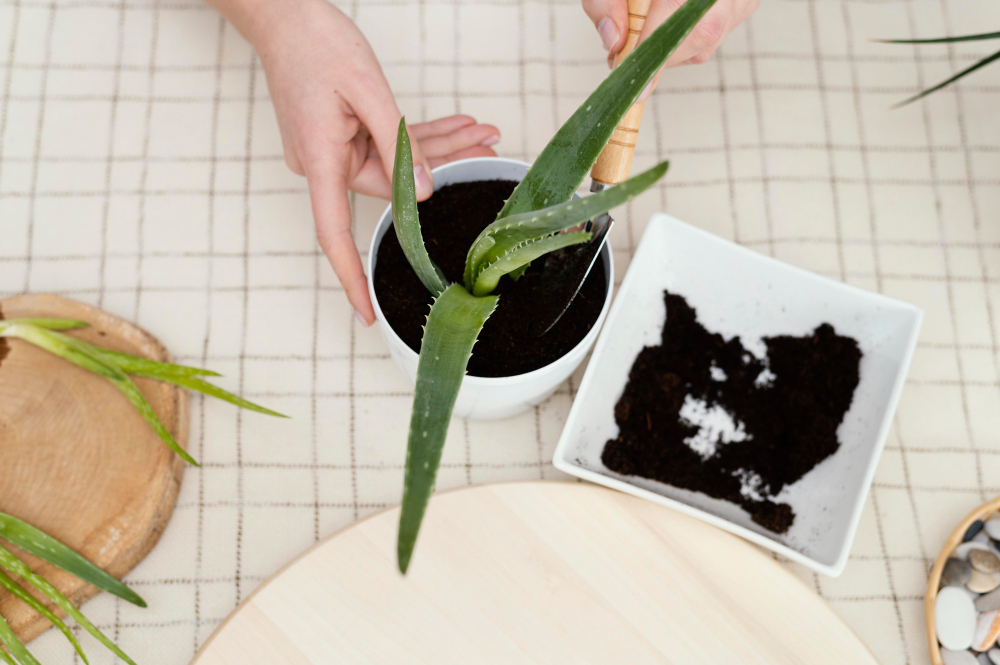
Image by Freepik
Aloe vera plants thrive in soil that drains well. Avoid using standard garden soil; instead, consider using a ready-made potting mix from stores or create your soil mixture by combining equal parts of sand, perlite, and peat moss. To prevent water from pooling around the roots, it’s crucial to use a pot with adequate drainage to allow excess water to escape. There’s no need to add a layer of gravel at the bottom of the pot.
Temperature
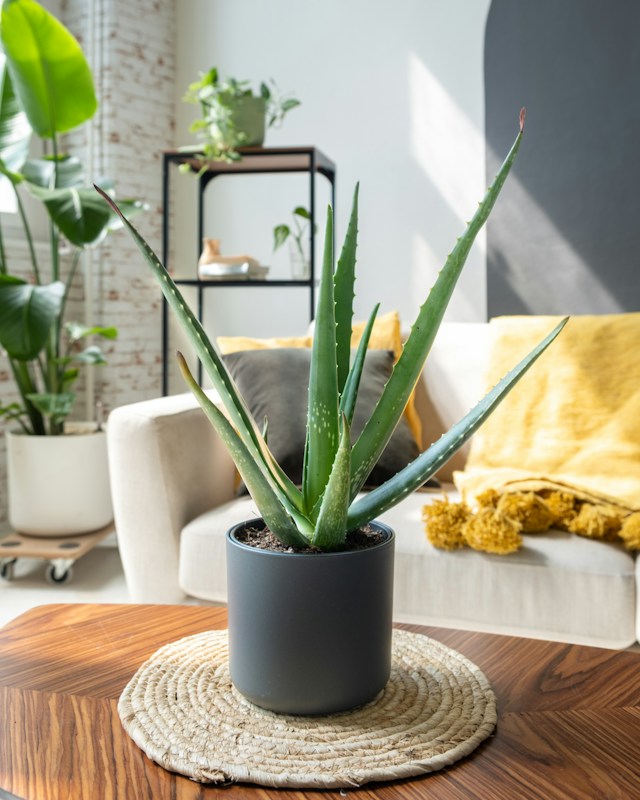
Aloe vera plants prefer warmer temperatures, ideally between 55 and 85 degrees Fahrenheit. In excessively low temperatures, their leaves may turn yellow or shrink. Also, avoid placing them in drafty spots where doors or windows frequently open and close. To maintain the health of your aloe plant, it’s crucial to keep it within the recommended temperature range and shield it from sudden temperature drops or drafts. Keep your aloe plant in a stable environment to maintain its health and prevent leaf damage.
Potting Your Aloe Plant
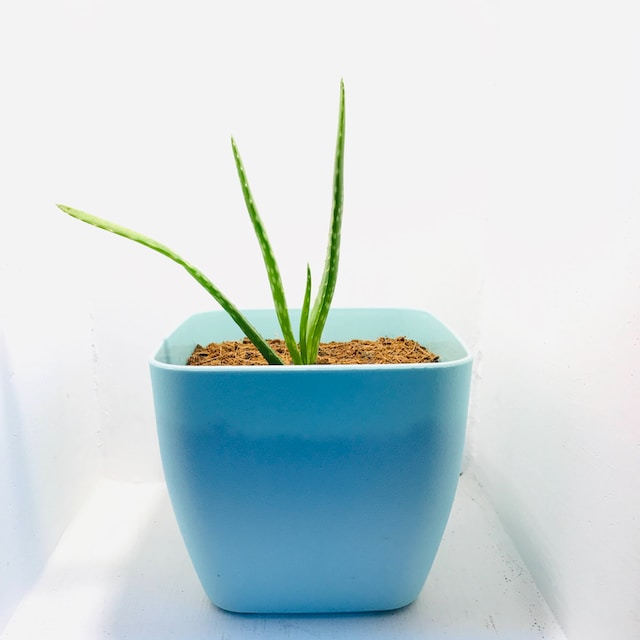
Choose a clay pot or porous pot for your delicate plant. These materials aid in maintaining soil dryness. While plastic pots can be used, they tend to retain moisture for a longer duration. Ensure the pot’s width matches its depth and select one that’s sufficiently heavy to prevent tipping over.
Additionally, consider the pot’s drainage capabilities, ensuring it has proper holes at the bottom to prevent water accumulation. This allows excess water to escape, promoting better soil aeration and preventing root rot.
Watch for pests
Keep an eye out for pests as aloe plants are prone to both mealybugs and aphids, which can harm your plant. Mealybugs have a waxy and oval shape, while aphids are small flying insects. These pests feed on the sap of your aloe vera plants. To eliminate them, use insecticidal soap by spraying it on your aloe plant.
Alternatively, you can remove mealybugs by rinsing your aloe with a forceful stream of water or applying neem oil to the plant.
Pruning
Trim wilted leaves near the bottom of your aloe plant. Pruning an aloe is essential only when it shows signs of dryness or decay in its foliage. Always cut the leaves close to the plant’s core to stimulate fresh growth. Additionally, trimming the leaves at an angle supports the growth of new foliage.
Aloe plants have an impressive capability to regenerate leaves after pruning. Once you remove the wilted parts, your plant will fill out again.
FAQS
What kind of potting soil should I select for my aloe vera plant?
Aloe vera plants need soil that drains well to avoid waterlogging their roots. You can use a special cactus or succulent potting mix available in stores. Alternatively, create your mix by combining equal parts of sand, perlite, and peat moss. Avoid using regular garden soil because it holds too much water, which can harm your aloe vera plant.
Are aloe vera plants safe for pets?
No, aloe vera plants are not safe for pets. The leaves contain toxins that can be harmful if ingested by cats, dogs, or other animals. It’s important to keep these plants out of reach to prevent accidental consumption by pets.
How do I trim or prune my aloe vera plant?
To prune your aloe vera plant, use clean, sharp scissors or shears to remove wilted or damaged leaves near the base of the plant. Cut the leaves close to the plant’s core to encourage new growth. Pruning helps maintain the plant’s health and appearance.
What mistakes should I avoid when caring for Aloe vera plants?
To keep your Aloe vera plant healthy, avoid overwatering, using soil that doesn’t drain well, exposing it to extreme temperatures, keeping it in low-light areas, and neglecting pest problems. Overwatering can cause root rot, while soil that doesn’t drain properly can lead to moisture issues. Extreme temperatures and insufficient light can stress the plant, and ignoring pests can harm its health.
Can I use any pot for planting my Aloe Vera?
No, it’s not advisable. Planting Aloe Vera in an overly large pot can cause excess water to accumulate near the roots, leading to a higher chance of overwatering. It’s better to choose a pot that is only slightly larger than the plant’s root system. Make sure the pot has adequate small holes to avoid water buildup in the soil.
How do I deal with pests on my aloe vera plant?
Common pests like mealybugs and aphids may infest aloe vera plants. To control these pests, use insecticidal soap, and neem oil, or rinse the plant with a forceful stream of water. Regularly inspect the plant for signs of pest infestation to address the issue promptly.
How long until an aloe vera plant blooms?
Aloe vera plants usually start flowering after a few years of growing to maturity. The time it takes can vary, but once mature, they may produce colorful tubular flowers in shades like red, yellow, or orange.
Caring for an Aloe vera plant is an enriching journey that combines beauty, health benefits, and the wonders of nature. From its tough nature to its vibrant blossoms, this succulent offers much to delight both experienced gardeners and those beginning their botanical journey. Following these guidelines, from proper light exposure and watering techniques to soil selection and pest control, ensures the well-being and thriving growth of your Aloe vera. Embrace the nurturing process, and you’ll find yourself rewarded with a resilient, stunning plant that embodies the harmony of beauty and natural healing.

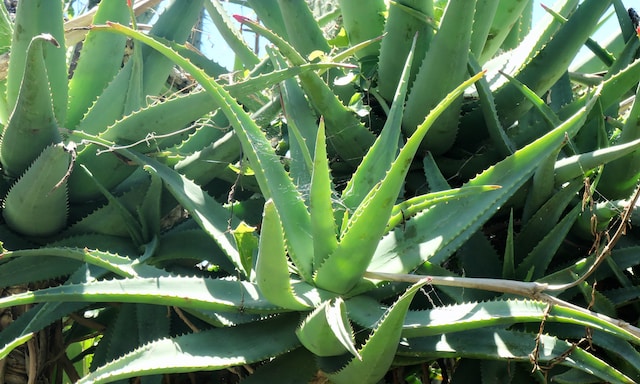
7 thoughts on “How To Take Care of Aloe Vera Plants:8 Important Steps”